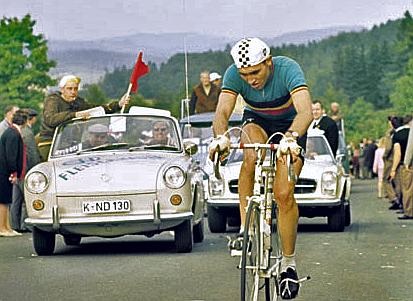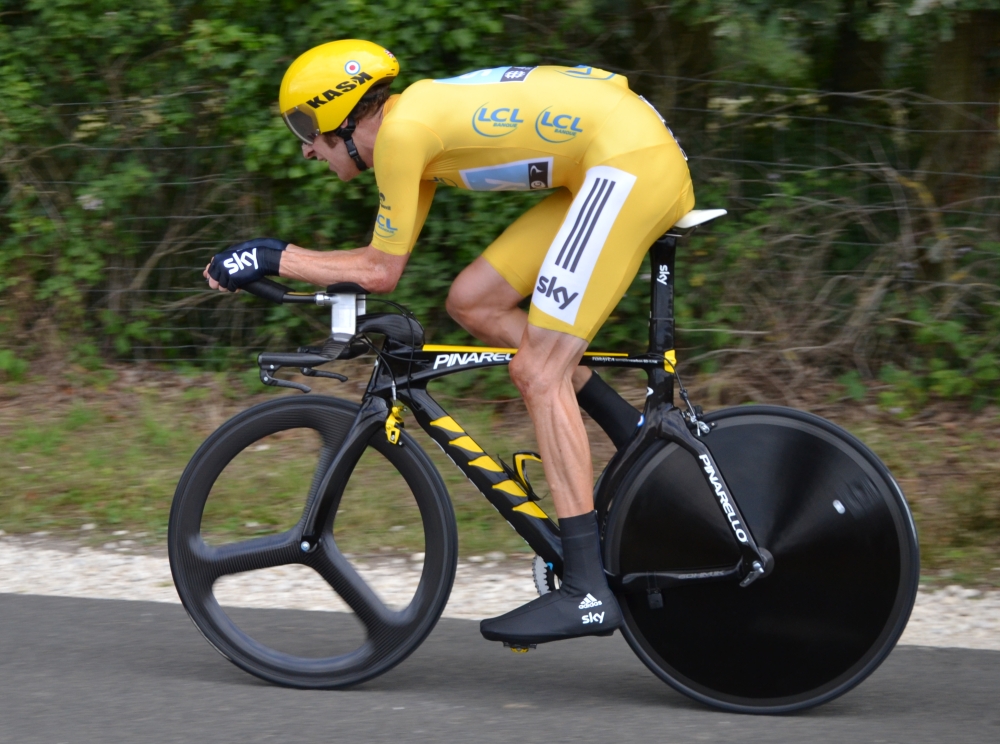|
1968 Giro D'Italia
The 1968 Giro d'Italia was the 51st running of the Giro d'Italia, one of cycling's Grand Tour races. The Giro started in Campione d'Italia, on 20 May, with a stage and concluded in Naples, on 11 June, with a mass-start stage. A total of 130 riders from 13 teams entered the 22-stage race, which was won by Belgian Eddy Merckx of the Faema team. The second and third places were taken by Italians Vittorio Adorni and Felice Gimondi, respectively. Teams At the route's announcement on 21 March, the organizers announced twelve teams of ten would participate; however, one more team (Peugeot) was later invited. Each team sent a squad of ten riders so the Giro began with a peloton of 130 cyclists. Out of the 130 riders that started this edition of the Giro d'Italia, a total of 98 riders made it to the finish in Naples where eight riders were subsequently disqualified for testing positive for drugs leaving the general classification tally at 90 riders. The starting peloton consisted o ... [...More Info...] [...Related Items...] OR: [Wikipedia] [Google] [Baidu] |
Eddy Merckx
Édouard Louis Joseph, Baron Merckx (, ; born 17 June 1945), better known as Eddy Merckx, is a Belgian former professional road and track bicycle racer who is among the most successful riders in the history of competitive cycling. His victories include an unequalled eleven Grand Tours (five Tours de France, five Giros d'Italia, and a Vuelta a España), all five Monuments, setting the hour record, three World Championships, every major one-day race other than Paris–Tours, and extensive victories on the track. Born in Meensel-Kiezegem, Brabant, Belgium, he grew up in Sint-Pieters-Woluwe where his parents ran a grocery store. He played several sports, but found his true passion in cycling. Merckx got his first bicycle at the age of three or four and competed in his first race in 1961. His first victory came at Petit-Enghien in October 1961. After winning eighty races as an amateur racer, he turned professional on 29 April 1965 when he signed with . His first major victory ... [...More Info...] [...Related Items...] OR: [Wikipedia] [Google] [Baidu] |
Gino Bartali
Gino Bartali (; 18 July 1914 – 5 May 2000), nicknamed Gino the Pious and (in Italy) Ginettaccio, was a champion road cyclist. He was the most renowned Italian cyclist before the Second World War, having won the Giro d'Italia twice, in 1936 and 1937, and the Tour de France in 1938. After the war, he added one more victory in each event: the Giro d'Italia in 1946 and the Tour de France in 1948. His second and last Tour de France victory in 1948 gave him the largest gap between victories in the race.Eurosport, Tour De France, 2008, Legends, Gino Bartali Eurosport.fr (4 July 2008). Retrieved on 6 August 2014. In September 2013, 13 years after his death, Bartali was recognised as a " |
Saint-Vincent, Aosta Valley
Saint-Vincent ( Valdôtain: ; Issime wae, Finze) is a town and ''comune'' in the Aosta Valley region of north-western Italy. Saint-Vincent, elevation , is a popular summer holiday resort with mineral springs. Geography The town is bounded by Ayas, Brusson, Châtillon, Emarèse and Montjovet Montjovet ( Valdôtain: ) is a town and ''comune'' in the Aosta Valley region of north-western Italy. Montjovet lies in the lower Aosta Valley, between France and Switzerland. Though it only has an area of 18.7 square kilometers, the commune has .... Notes and references Cities and towns in Aosta Valley {{Aosta-geo-stub ... [...More Info...] [...Related Items...] OR: [Wikipedia] [Google] [Baidu] |
Novara
Novara (, Novarese: ) is the capital city of the province of Novara in the Piedmont region in northwest Italy, to the west of Milan. With 101,916 inhabitants (on 1 January 2021), it is the second most populous city in Piedmont after Turin. It is an important crossroads for commercial traffic along the routes from Milan to Turin and from Genoa to Switzerland. Novara lies between the rivers Agogna and Terdoppio in northeastern Piedmont, from Milan and from Turin. History Novara was founded around 89 BC by the Romans, when the local Gauls obtained the Roman citizenship. Its name is formed from ''Nov'', meaning "new", and ''Aria'', the name the Cisalpine Gauls used for the surrounding region. Ancient ''Novaria'', which dates to the time of the Ligures and the Celts, was a municipium and was situated on the road from Vercellae (Vercelli) to (Mediolanum) Milan. Its position on perpendicular roads (still intact today) dates to the time of the Romans. After the city was destroyed in ... [...More Info...] [...Related Items...] OR: [Wikipedia] [Google] [Baidu] |
Charly Grosskost
Charly Grosskost (5 March 1944 – 19 June 2004) was a French racing cyclist who in 1968 won the prologue time-trial of both the Giro d'Italia and the Tour de France. He won stages of the Tour de France and of the Giro d'Italia and on the track was French pursuit champion nine times. His sporting career began with A.C.B.B. Paris. Early career Grosskost came to notice when he was 19, when he won a stage of the Route de France – amateur counterpart of the Tour de France – and then won Strasbourg-Campagne by nearly 10 minutes after riding ahead of the race for more than 50 km. In 1965, he won the Route de France and five of its seven stages and became favourite for the still bigger race, the Tour de l'Avenir. There, however, he dropped out in the Pyrenees. A drug test that followed his retirement – it has entered cycling legend that other riders pushed him off his bike for his own safety as he began foaming at the mouth and riding erratically – led to his being suspen ... [...More Info...] [...Related Items...] OR: [Wikipedia] [Google] [Baidu] |
Individual Time Trial
An individual time trial (ITT) is a road bicycle race in which cyclists race alone against the clock (in French: ''contre la montre'' – literally "against the watch", in Italian: ''tappa a cronometro'' "stopwatch stage"). There are also track-based time trials where riders compete in velodromes, and team time trials (TTT). ITTs are also referred to as "the race of truth", as winning depends only on each rider's strength and endurance, and not on help provided by teammates and others riding ahead and creating a slipstream. Individual time trial are usually held on flat or rolling terrain, although sometimes they are held up a mountain road (in Italian: ''cronoscalata'' "chrono climbing"). Sometimes the opening stage of a stage race is a very short individual time trial called a prologue (8 km or less for men, 4 km or less for women and juniors). Starting times are at equal intervals, usually one or two minutes apart. The starting sequence is usually based on the finishing times ... [...More Info...] [...Related Items...] OR: [Wikipedia] [Google] [Baidu] |
Time Trial
In many racing sports, an athlete (or occasionally a team of athletes) will compete in a time trial against the clock to secure the fastest time. The format of a time trial can vary, but usually follow a format where each athlete or team sets off at a predetermined interval to set the fastest time on a course. Variation in sports Cycling In cycling, for example, a time trial (TT) can be a single track cycling event, or an individual or team time trial on the road, and either or both of the latter may form components of multi-day stage races. In contrast to other types of races, athletes race alone since they are sent out in intervals (interval starts), as opposed to a mass start. Time trialist will often seek to maintain marginal aerodynamic gains as the races are often won or lost by a couple of seconds. Skiing In cross-country skiing and biathlon competitions, skiers are sent out in 30 to 60 second intervals. Rowing In rowing, time trial races, where the boats are se ... [...More Info...] [...Related Items...] OR: [Wikipedia] [Google] [Baidu] |
Mediterranean Ocean
The Mediterranean Sea is a sea connected to the Atlantic Ocean, surrounded by the Mediterranean Basin and almost completely enclosed by land: on the north by Western and Southern Europe and Anatolia, on the south by North Africa, and on the east by the Levant. The Sea has played a central role in the history of Western civilization. Geological evidence indicates that around 5.9 million years ago, the Mediterranean was cut off from the Atlantic and was partly or completely desiccated over a period of some 600,000 years during the Messinian salinity crisis before being refilled by the Zanclean flood about 5.3 million years ago. The Mediterranean Sea covers an area of about , representing 0.7% of the global ocean surface, but its connection to the Atlantic via the Strait of Gibraltar—the narrow strait that connects the Atlantic Ocean to the Mediterranean Sea and separates the Iberian Peninsula in Europe from Morocco in Africa—is only wide. The Mediterranean Sea enc ... [...More Info...] [...Related Items...] OR: [Wikipedia] [Google] [Baidu] |
Mount Vesuvius
Mount Vesuvius ( ; it, Vesuvio ; nap, 'O Vesuvio , also or ; la, Vesuvius , also , or ) is a somma-stratovolcano located on the Gulf of Naples in Campania, Italy, about east of Naples and a short distance from the shore. It is one of several volcanoes forming the Campanian volcanic arc. Vesuvius consists of a large cone partially encircled by the steep rim of a summit caldera, resulting from the collapse of an earlier, much higher structure. The eruption of Mount Vesuvius in AD 79 destroyed the Roman cities of Pompeii, Herculaneum, Oplontis, Stabiae, and several other settlements. The eruption ejected a cloud of stones, ashes and volcanic gases to a height of , erupting molten rock and pulverized pumice at the rate of per second. More than 1,000 people are thought to have died in the eruption, though the exact toll is unknown. The only surviving eyewitness account of the event consists of two letters by Pliny the Younger to the historian Tacitus. Vesuvius has ... [...More Info...] [...Related Items...] OR: [Wikipedia] [Google] [Baidu] |
General Classification In The Giro D'Italia
The general classification in the Giro d'Italia is the most important classification of the Giro d'Italia, which determines who is the overall winner. It is therefore considered more important than secondary classifications as the points classification or the mountains classification. Since 1931, the leader of the general classification is identified by a pink jersey ( it, maglia rosa ). Prior to that year and since the creation of the race, no colour was used to distinguish the winner at the top of the classification. The first rider to wear the maglia rosa was Learco Guerra following the first stage of the 1931 Giro d'Italia. The first jersey was entirely pink and made from wool. It had a roll-neck collar and front pockets. As Italy was under Fascist Party rule there was a gray shield stitched onto the shirt, a symbol for the party. This initial jersey and many of the first pink jerseys were designed by Vittore Gianni who had created jerseys for AC Milan and Juventus. Castelli ... [...More Info...] [...Related Items...] OR: [Wikipedia] [Google] [Baidu] |






